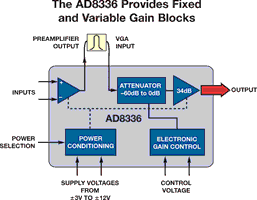

Many of the applications that we take for granted operate in real-world environments with high levels of dynamic range. The most common of these systems are radio and television receivers and their updated cousins – the cellphone and the iPod.
The signal range for these types of household devices can vary from a few microvolts in remote areas to volts when the device is near the signal source. Situations with wide dynamic range are also found in scientific, industrial, and medical applications - such as the 'front ends' of measurement equipment, ultrasound imaging for biological diagnostics, and industrial fault analysis.
Designers have been faced with the dual challenges of providing the highest sensitivity amplifiers possible while at the same time making them operable under severe overload conditions. In the early days of electronics, solutions to these challenges were sought by 'tinkering' with the amplification devices. In the case of vacuum tubes, this involved adding control grids within the tube structure to alter the conductivity, and thus the gain of the device. For transistors, electronic gain control was limited to adjusting the DC base or emitter currents. While these solutions were relatively successful, they typically compromised linearity and distortion performance.
A more viable solution had to wait until the advent of highly complex integrated circuits in the late 1980s, when Analog Devices invented and introduced the AD600 - the first solid-state variable gain amplifier (VGA) to operate in a linear manner. This amplifier was also called the X-amp or exponential amplifier. The advantages of this device lie in its architecture - a passive electronic gain control implemented with a resistive ladder network and followed by a fixed-gain amplifier. There are six to eight 'rungs' on the ladder, connected to an 'interpolator circuit' that sweeps across the ladder in response to an externally supplied control voltage. This concept has been the basis for many subsequent products that offer additional features and enhanced performance. However, the basic gain-control architecture has not changed.
The AD8336 is one of several newer solutions in Analog Devices' VGA portfolio. This device offers an attractive balance of size, performance, and circuit versatility while operating across wide power supply voltage and dissipation ranges. The versatile AD8336 variable gain amplifier features an uncommitted, fully independent voltage feedback op-amp to which AC- or DC-coupled signals of either polarity can be applied. The preamplifier output can be applied directly to the VGA input - or interstage selectivity or filtering can be inserted between the preamplifier and VGA. The preamplifier can be connected as a summing stage or differentially like any high frequency op amp - enabling fast, convenient interconnection to virtually any signal source.
Just as the preamplifier is capable of differential connections, so too is the gain control input. The input may be ground-referenced or connected from a reference supply appropriate to the gain control source. This capability is particularly useful with cascading devices. For higher voltage applications, the device may be operated from supplies as high as ±12 V or as low as ±3 V for battery operation. To conserve battery life, the power may be reduced by approximately 50% at the expense of bandwidth. Analog Devices offers an extensive portfolio of variable gain amplifiers for applications such as ultrasound, radar and wireless communications.

© Technews Publishing (Pty) Ltd | All Rights Reserved